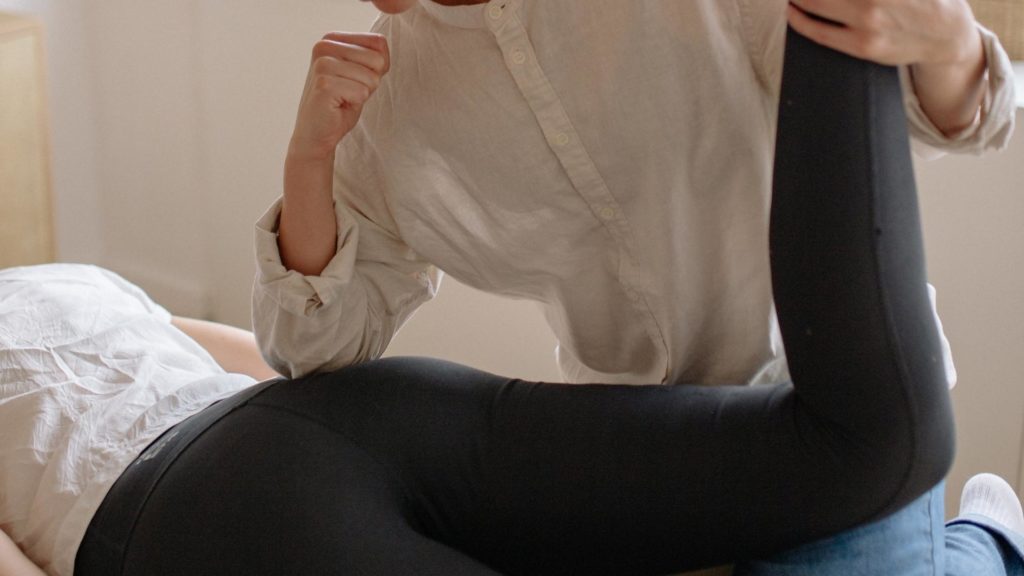
Piriformis Syndrome: Does Piriformis Cause Sciatica & Hip pain?
Piriformis Syndrome is a diagnosis that states the hip and leg pain that you’re experiencing is the cause of a tight or dysfunctional Piriformis. Sciatica is also often directly associated with Piriformis Syndrome as symptoms of these two are fundamentally the same. Today we’re going to once and for all give you the complete guide to Piriformis Syndrome so you can finally disregard this misdiagnosis for good, and start working instead on the cause of your symptoms.
So what is Piriformis Syndrome?
The best place to begin is to identify what a diagnosis of Piriformis Syndrome is implying, and then break down the diagnosis from there. By doing this, the argument against Piriformis Syndrome as a helpful or even credible diagnosis will reveal itself. Hopefully giving you a comprehensive understanding in the process.
Piriformis is one of six lateral hip rotators, small muscles that are somewhat similar to the rotator cuff muscles in the shoulder. Piriformis and the other rotators are underneath the larger Gluteal muscles; most notably Gluteus Maximus and like the Gluteal muscles, it receives it’s control from the lower part of the lumbar spine, specifically the L5 and S1 nerve roots, more on this later.
The peculiarity that is often closely referenced in cases of Piriformis Syndrome lies in the anatomical variation in the relationship between the Piriformis muscle and the Sciatic nerve. As we’ll explore later, this is a red herring. To put it simply, as the Sciatic nerve leaves our pelvis to travel down the back of your thigh by passing underneath the Piriformis muscle, however in some of us, the passage pierces the Piriformis muscle.
In the case of Piriformis Syndrome it is said that tightness, injury, contraction, or stiffness, is resulting in compression of the Sciatic nerve as it makes the above journey past or through Piriformis. This irritation is what is leading to the symptoms of hip and/or leg pain.
The solution, to simply release the Piriformis through direct pressure massage, acupuncture, foam rolling, peculiar stretching… The list goes on. If you’ve followed any of our educational videos or the Back In Shape Program itself this will sound an awful lot like the approach to the “muscle spasm causing back pain” issue – an approach that is as common as it is incorrect.
Your Piriformis muscle does not cause back pain or sciatica
Certainly uncontrolled muscle spasm can make back injuries worse, as they can with many different injuries. The problem with the implication Piriformis Syndrome is making, is that it is stating the tight or contracted muscle is causing the pain. Our bodies just aren’t this vulnerable. If this were true, you’d expect every time you contract your Piriformis you’d feel a jolt of pain – but you don’t. Even if you are one of the few who’s Sciatic nerve pierces the Piriformis muscle, you’ve been like this your whole life! Piriformis Syndrome has been a feature for a fraction of that time – to state that a contractile or tight muscle has somehow caused this pain you’re experiencing just makes no sense.
Now you’d be forgiven for thinking that we are disputing that the muscle is tight or dysfunctional in some way. It is most likely that the Piriformis is dysfunctional in some manner, along with the other muscles in the region that we mentioned earlier. You could try and make the case that the Piriformis was somehow uniquely strained through some activity, however any clinician worth their salt would not dream of suggesting you have the capacity to somehow load your Piriformis, and solely the Piriformis to such a degree that it is the only muscle injured. When spelled out it does sound rather preposterous doesn’t it? Especially when you think of the huge and powerful Gluteus Maximus which is directly superficial to the Piriformis and other lateral hip rotators (layed on top of).
No, muscles don’t just get tight, just get injured or “just contract” and muscle spasm isn’t the cause of your pain.
There is always a cause. That is what we must address for success.
The real cause of Piriformis Syndrome
Why is it that you’re always given stretches when diagnosed with Piriformis Syndrome? It seems to provide a moment of relief and you go round in circles. Probably with a regular practice of knee hugs no less. If we think back to Sciatica mentioned earlier, a better way to phrase Sciatica and the symptoms of Piriformis Syndrome would be something like “Lumbogenic leg pain” or “Lumbogenic hip pain” – Pain in the hip or leg that is generated in the lumbar spine.
You’ll recall that we didn’t dispute there may well be some degree of dysfunction in the Piriformis, which is why it’s perhaps sore when pressed. But don’t be mistaken, when a clinician digs their elbow into that spot, they’re pressing HARD and certainly also on the gluteals, and likely not only on the Piriformis.
All of these muscles are controlled by the L5 and S1 nerve roots. These two nerve roots leave the spine to combine with others forming the Sciatic nerve in the pelvis. They are also commonly compressed or irritated at the level of the L4, L5 intervertebral junction and the Lumbosacral junction at L5, S1. Injuries like disc bulges, facet strains to name a few, can create inflammation in this region and irritate these nerve roots.
It is common to then experience pain, numbness, burning, contracture of muscles etc, in regions controlled by those nerves. Remember all those muscles we mentioned earlier, yes, all of those or some of them could well become slightly dysfunctional, tight, weak or stiff, as a result of an injury to the lower back at the levels mentioned in the previous paragraph.
So you are right that there is something wrong in that area of the hip, but it is a symptom of the problem, rather than the cause.
Why is Piriformis Syndrome such a problem
Simply put, it’s a misdiagnosis of “Lumbogenic hip or leg pain”. These errors in diagnosis are so problematic for two reasons. Firstly, you’re spending time doing the wrong exercises. Focusing on Piriformis Syndrome and stretching the tight muscle invariably involves a lot of forward bending of the lumbar spine – rounding the back. These exercises are often making the underlying issue worse on a regular basis. Of course it feels nice to stretch the hip muscles, but you’ll find yourself doing it more and more with less and less relief as you continue to practice movements with no regard for your lower back as in your mind, once diagnosed with Piriformis Syndrome, there’s nothing wrong with the lower back.
The second consequence of a Piriformis Syndrome diagnosis, is that you’re not doing things that fundamentally can help you, strengthening, relearning how to move correctly, bracing the core and lumbar spine to protect the injured site. Being more conscientious of how you move, the list goes on. Fundamentally, the practices we preach, inside the Back In Shape Program. By missing out on doing these exercises and learning these movement skills, you continue to allow time to march on.
Quite simply, muscles don’t cause problems, they react to them. The Piriformis is a tiny muscle that makes up a group of muscles that are commonly affected by injuries to the lower back. The tightness that often results in these lower back injuries clearly doesn’t help the lower back, but focusing on the muscles first is a sure fire way to go round in circles for a long time. And if the Piriformis & Gluteus Maximus weren’t that bad before, a good few hours of direct pressure from elbows and cricket balls will certainly do the trick to make them a lot less healthy.
Next time you take a chicken breast out the fridge, place it on the kitchen counter and lean into it with your elbow for 5 minutes. Ask yourself the question, does that really look like it would be helpful if that muscle is already receiving erroneous input from the nerves controlling it, does it really look like that’s going to accelerate the healing process? Or does it look like if you do that long enough, you might well be creating a problem you don’t want to have?
Don’t let comments like this affect you, they have little impact on what you need to do to get your back in shape!
Comment of the week – Keith
“I’m feeling much healthier all round and breathing much better presumably due to the exercise which I’ve never really done before”
3 Ways You Can Fix Piriformis Syndrome
- Leave it alone!
That muscle is tiny, and chances are its had more than enough direct stimulation, the massage, elbows and foam rolling are probably making things more volatile! Start off by leaving the area alone and doing no more direct work, certainly for the next week or so while you work on points 2 and 3
- Start with control of your low back and relieving the lower lumbar spine
Get started by adding in some gentle decompression to the lower back, the towel exercise for example is a great way to unload the lower lumbar spine. You can also use ice for short blasts of 2-5 minutes over the lower lumbar spine – NOT The Piriformis muscle. In addition to this, learning to get control over your core muscles and using them to maintain a neutral lumbar spine is vital.
- Build strength to both the core and the hips
By rebuilding the strength in both the hips and the trunk, you’ll be able to safeguard the lower back while it is healing and steadily you’ll find your Piriformis Syndrome starts to ease. You might also find that when you begin strengthening the hips, the side you have the Piriformis Syndrome on is weaker than the other. Over time you’ll be able to work these weaknesses out and get Back In Shape!
If you need help with your Piriformis Syndrome specifically there are 2 ways we can help you further:
1) Join the Back In Shape Program and make a start today! Click here >>
2) Already a member? Make sure you bring your Piriformis Syndrome questions to the next Live Q&A – remember we’re here to help you!









Responses